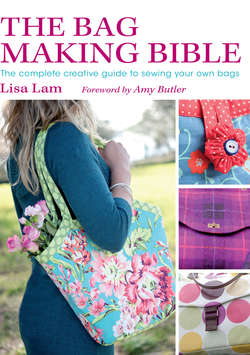Читать книгу The Bag Making Bible - Lisa Lam - Страница 7
На сайте Литреса книга снята с продажи.
ОглавлениеThe Sewing Machine
A sewing machine is the most important tool in making bags (and sewing in general) but it doesn’t need to be a grand or costly affair. There are only two features that I insist on: a powerful motor and a free arm (see below). The others listed here, while not essential, are useful to have. If buying a sewing machine and you want unbiased reviews and advice there are lots of good resources on the Internet. There are also numerous books available on getting the most of out of your machine, which are well worth investigating.
• Powerful motor – a must for coping with all of those fabric (and interfacing) layers.
• Good stability – when sewing at breakneck speeds or working with thick layers the last thing you want is your machine to shake and judder. Choose a machine that has a good weight and a wide stable base. Ask to see or test the machine in action at maximum speed.
• Build quality – how solid does the machine feel? I prefer heavy machines (the more metal the better) because they will last longer (with fewer machine services) and they will vibrate less.
• Instruction manual – I am a stickler for a good manual because no matter how experienced you are there will be plenty of occasions when you’ll need to turn to it for help. Don’t be shy in the shop; ask to have a flick through the machine manual. Also look on the Internet for support and user manuals for your machine.
• Bobbin winding system – different sewing machines have different systems for bobbin winding. While in the shop, ask to see how the bobbin is wound and check you are happy with the method.
• Dual feed system – this is a feature on some machines that makes working with several and/or thick layers much easier because this system feeds the layers through the machine evenly and at the same speed. In normal sewing the bottom layer gets fed through the machine just before the top layer and this results in the top layer creeping forwards, which can be a real pain.
Machine feet
There are various feet required for different kinds of stitches and applications, so you need to think about the stitches you want to use and research to see which types of feet are appropriate for your needs. If you are about to purchase a sewing machine, see which feet are supplied with the machine, then ask the dealer if they will throw in some extra feet for free (and ask about any other freebies too!).
• Standard presser foot – this is the foot that you will make the most use of. With this versatile foot you can sew straight and zigzag stitch, and the majority of the more decorative stitches too.
• Clear presser foot – this is a standard presser foot, but instead of being metal, it’s made from transparent plastic, which makes seeing things like notches and markings on your fabric so much easier.
• Piping foot – if you’re going to sew with any amount of piping, a piping foot is a must, see Piped Edges.
• Zipper foot – makes sewing very close to the edge of an item much easier, and is also essential for sewing zips.
• Non-stick foot – this foot is brilliant for ‘sticky’ fabric such as oilcloth, vinyl and leather (see Fabric Types).
• Seam allowance guide – this is not a foot, but is a handy metal edge that screws to the bed of the machine and is very useful for professional-looking topstitching. Set your desired seam allowance on the guide, then butt the edge of your work to the seam allowance guide and away you go.
Machine stitches
I’ve been making bags for over six years and in that time I’ve only ever used two machine stitches.
Straight stitch This is basically the only stitch I ever really use.
Zigzag stitch Every now and again I use zigzag to stitch over the raw edges of fabric to prevent it from fraying (The Versatile Book Bag, step 2).
